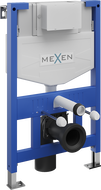
Concealed frames, on which the toilet bowl is hung, are an ideal solution for any bathroom, regardless of its size, shape, or design style. By hiding all structural components in the wall, they offer an impressive alternative to traditional sanitary ceramics. Their use not only affects the aesthetics of the interior but also enhances the safety and functionality of use. How to select the right model of concealed frame and how to install it correctly?
How to choose a frame for installation?
The most popular and commonly used concealed sets include frames designed for wall-hung toilet bowls and bidets, although there are also structures available for the installation of urinals and sinks. They are selected based on the planned functions, load of the installation, and the mounting method, specifically the type of wall they will be installed on.
In the extensive commercial offer of various manufacturers, one can find frames for dry installation, suitable for lightweight walls, e.g., gypsum plasterboard, and concealed frames for heavy (wet) installation for brick walls that require cladding. The decision on which model of toilet frame to choose depends on the conditions in our bathroom. Regardless of the chosen model, it is worth remembering to have an internal foam filling, which effectively dampens unwanted noises.
Preparation for installing a concealed frame
When selecting a concealed frame, attention should be paid to several aspects important for its installation and future use:
- each concealed frame should have a technical approval that confirms it has been manufactured in accordance with applicable standards;
- the arm of the frames for lightweight installation should be able to withstand the weight of the installed ceramic and the user. In the case of a toilet bowl frame, the construction must withstand a static load of up to 400 kg, for a sink, this standard is 150 kg;
- a stable frame for lightweight installation has at least four fastening points: two to the wall and two to the floor;
- self-supporting frames are characterized by a reinforced frame and a profile with a larger cross-section;
- the warranty offered by the manufacturer is important, as its length indicates the product's quality and durability,
- it is worth asking how many years spare parts will be available on the market (reputable brands, e.g., Geberit, offer service for up to 25 years).
Concealed frame for installation - installation conditions
The installation conditions for concealed frames are the same for all types of ceramic fixtures, whether we are installing a toilet bowl, bidet, sink, or urinal. The basic principle is to properly level and maintain the vertical alignment of each element of the frame. An improperly set frame can cause discomfort during use, as well as lead to structural inaccuracies that make it difficult to clad with plasterboard, affecting the interior's aesthetics. Therefore, the installation of the frame should be preceded by measuring all installed components so that the sanitary elements are positioned at the desired height.
Some frames are equipped with a height marking of 1 m from the floor, and the majority have smooth adjustment in vertical and horizontal directions. It is noteworthy that each model is different for completing with ceramics, so it is best to opt for a compatible set equipped with all the necessary elements for correct installation.
Heavy installation frame - place and method of installation
Concealed sets for heavy installation are primarily used in newly built bathrooms with brick walls. They are slightly thinner, as the load of maintaining the entire construction is transferred to the wall. They offer many advantages. They are cheaper than frames for dry installation, take up significantly less space in the bathroom, and allow for the complete concealment of the cistern without the need to build additional shelves. However, it should be noted that a failure of any component requires wall chiseling.
And what does proper installation of a concealed frame look like? The frame arm for wet installation and the flush tank must first be screwed to the wall, and the filling tank connected to the water system. Next, the toilet bowl should be screwed on. When dealing with a vertical outlet from the flush tank, the frame is clad from the sides and at the bottom, while for a side outlet, additional supports can be used from the bottom to offload the entire construction. After installing the frame in the brick wall, the entire construction and pipes need to be plastered or covered with gypsum plasterboard. Tiles can be adhered to these or another type of finish applied.
Frames for lightweight installation - types and advantages
The standard frame for lightweight installation is 35 to 50 cm wide and 10 to 25 cm deep. Available on the market are low installation WC concealed sets, where the frame is 80 cm or 90 cm, and high, with a frame from 110 to 130 cm. A separate type is freestanding self-supporting frames, with four-point floor mounting to the concrete floor. It can be easily hidden behind a plasterboard wall cover. Only the bowl and the flush button remain visible. Such a construction looks neat, is safe and stable. Due to its small dimensions, it allows for saving a lot of space, especially in a small bathroom. These features, along with simple installation and easy frame coverage, often lead customers to choose this system for their bathroom.





















